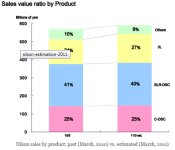Browncoat
Senior Member
...Nikon's marketing dept - has determined that the PNS segment is were the money is. Nikon sells way more Coolpixs than DSLRs...
This is incorrect.
The money is, and always has been, in the SLR market. Point and shoot cameras are a one and done deal. Consumers buy the $100 camera, and they're gone. There's no aftermarket, no extended product line. With SLRs, the cameras cost 10x as much. Then there's always additional lenses, batteries, grips, and other accessories. For the most obvious example, just take a look at this forum. The PnS section hardly gets used. People buy PnS cameras because they're cheap and simple. You won't find many PnS consumers who are dedicated to the Nikon brand like the SLR users are. SLRs are an investment, not an impulse purchase.
In addition, the Nikon 1 series is aimed at the high end PnS/low end SLR user. Snappers aren't going to buy this camera, not when the average snapper mindset is trending towards cell phone cameras. It's way out of their price range.
According to market research, the D3000 and D5000 were largely failures for Nikon. The D3100 helped pep things up a bit, but overall, Nikon's targeting of the low end of the spectrum did not fare well with consumers. Enter the Nikon 1 series. This camera is their attempt to regain this market share. Nikon typically holds 30-35% of the overall camera market (either 2nd place or flip-flops with Canon), but they are particularly weak on the low end SLR market.


